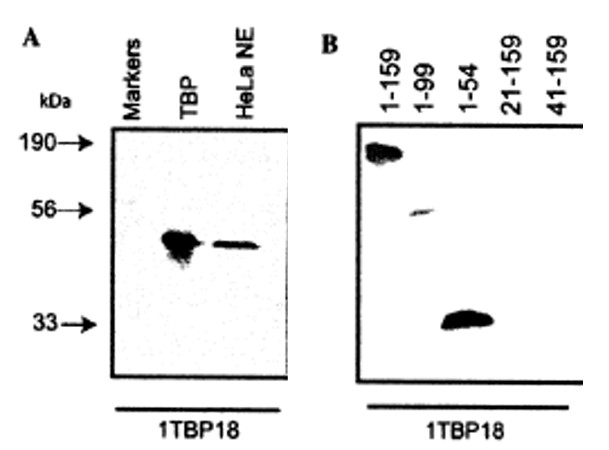Anti-TATA Binding Protein [Clone 1TBP18]
Anti-TATA Binding Protein [Clone 1TBP18]
Product No.: 70102
- -
- -
Clone 1TBP18 Target TATA Binding Protein Formats AvailableView All Product Type Monoclonal Alternate Names TATA sequence-binding protein, TATA-binding factor, TATA-box factor, Transcription initiation factor TFIID TBP subunit Isotype Mouse IgG1 Applications IP , WB , EMSA |
Data
- -
- -
Antibody DetailsProduct DetailsReactive Species Human ⋅ Mouse ⋅ Rat Host Species Mouse Immunogen Recombinant human TBP. Product Concentration Lot Specific Formulation This monoclonal antibody is aseptically packaged and formulated in 0.01 M phosphate buffered saline (150 mM NaCl) PBS pH 7.2 - 7.4 with no carrier protein, potassium, calcium or preservatives added. State of Matter Liquid Product Preparation Purified by Protein G affinity chromatography Storage and Handling This antibody is stable for at least one (1) year at -20°C to -70°C. Store product in appropriate aliquots to avoid multiple freeze- thaw cycles. Country of Origin USA Shipping Next Day 2-8°C Applications and Recommended Usage? Quality Tested by Leinco This antibody may be used in Western blot and electrophoretic mobility (gel shift) assays to detect mammalian TBP. It may also be used to immunoprecipitate a truncated TBP molecule containing only the N-terminal domain. Each investigator should determine their own optimal working dilution for specific applications. See directions on lot specific datasheets, as information may periodically change. DescriptionDescriptionSpecificity Clone 1TBP18 is a monoclonal Antibody that recognizes an epitope within amino acid residues 1-20 of human, mouse and rat TBP. It does not react with TBP from Drosophila, yeast, silk worm, or Xenopus. Other species not investigated. Background The TATA-binding protein (TBP) plays a central role in the assembly of most eukaryotic transcription initiation complexes. TBP assembles with other proteins to form unique multimeric complexes for each of the three different nuclear RNA polymerases. TBP has been cloned from a variety of species and consists of two distinct domains. The C-terminal domain (~180 amino acids) is highly conserved among species, whereas the N-terminal domain varies considerably in length and sequence among different species. The conserved C-terminal domain contains the DNA-binding region as well as regions that interact with positive and negative regulatory proteins. In human TBP, the non-conserved N-terminal domain includes a stretch of glutamine residues ranging from 26 to 42. Several research groups have found an association between expansion of this polyglutamine tract with rare forms of spinocerebellar ataxia and other neurodegenerative diseases including Huntington's disease. Key Features and Scientific Rationale of Anti-TBP (Clone 1TBP18): Ubiquitous Transcriptional Core Factor: TBP is the foundational subunit of Transcription Factor II D (TFIID) and is indispensable for the accurate initiation of transcription by all three nuclear RNA polymerases (Pol I, Pol II, and Pol III). Its precise binding to the TATA box sequence within promoter regions dictates the assembly of the pre-initiation complex. Our antibody provides a robust means to investigate this central orchestrator of eukaryotic gene expression and transcriptional regulation. Critical Reagent for Polyglutamine Disease Research: The N-terminal domain of human TBP contains a polymorphic polyglutamine (polyQ) tract (26-42 residues). Pathological expansions of this glutamine repeat are directly implicated in the etiology of several debilitating neurodegenerative diseases, including Huntington's disease and specific forms of spinocerebellar ataxia (SCA17). Our Anti-TBP antibody (Clone 1TBP18) is an invaluable tool for: Probing the cellular localization and expression levels of TBP in disease models. Investigating the impact of polyQ expansions on TBP function and protein aggregation. Exploring the molecular pathology and potential therapeutic strategies for polyglutamine disorders. Function General transcription factor that functions at the core of the DNA-binding multiprotein factor TFIID (PubMed:2374612, PubMed:2363050, PubMed:2194289, PubMed:9836642, PubMed:27193682). Binding of TFIID to the TATA box is the initial transcriptional step of the pre-initiation complex (PIC), playing a role in the activation of eukaryotic genes transcribed by RNA polymerase II (PubMed:2374612, PubMed:2363050, PubMed:2194289, PubMed:9836642, PubMed:27193682). Component of a BRF2-containing transcription factor complex that regulates transcription mediated by RNA polymerase III (PubMed:26638071). Component of the transcription factor SL1/TIF-IB complex, which is involved in the assembly of the PIC (pre-initiation complex) during RNA polymerase I-dependent transcription (PubMed:15970593). The rate of PIC formation probably is primarily dependent on the rate of association of SL1 with the rDNA promoter. SL1 is involved in stabilization of nucleolar transcription factor 1/UBTF on rDNA. {PubMed:15970593, PubMed:2194289, PubMed:2363050, PubMed:2374612, PubMed:26638071, PubMed:27193682, PubMed:9836642, ECO:0000305}. NCBI Gene Bank ID UniProt.org Research Area Protein Transcription References & Citations1. Thompson NE et al. 2004. Protein Expression and Purification 36: 186-197. 2. Garcia-Jove Navarro, M., Basset, C., et al. PLoS One . 2013. 8(8):e71443 3. Ribeiro, J. R., Lovasco, L. A., et al. Front Oncol . 2014. 4:45 4. Bouwman, R. D., Palser, A., et al. Retrovirology . 2014. 11:53 5. Leonard, A., Paton, A. W., et al. PLoS One . 2014. 9(10):e110949 6. Kang, K. A., Piao, M. J., et al. Oncotarget. 2016. 7(26):40594-40620 7. Cai, T., Sun, D., et al. J Cell Mol Med. 2018. 22(3):1684-1695 Technical ProtocolsCertificate of Analysis |



